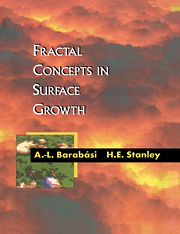Book contents
- Frontmatter
- Contents
- Preface
- Notation guide
- PART 1 Introduction
- PART 2 Nonequilibrium roughening
- PART 3 Interfaces in random media
- PART 4 Molecular beam epitaxy
- PART 5 Noise
- PART 6 Advanced topics
- PART 7 Finale
- APPENDIX A Numerical recipes
- APPENDIX B Dynamic renormalization group
- APPENDIX C Hamiltonian description
- Bibliography
- Index
APPENDIX A - Numerical recipes
Published online by Cambridge University Press: 23 December 2009
- Frontmatter
- Contents
- Preface
- Notation guide
- PART 1 Introduction
- PART 2 Nonequilibrium roughening
- PART 3 Interfaces in random media
- PART 4 Molecular beam epitaxy
- PART 5 Noise
- PART 6 Advanced topics
- PART 7 Finale
- APPENDIX A Numerical recipes
- APPENDIX B Dynamic renormalization group
- APPENDIX C Hamiltonian description
- Bibliography
- Index
Summary
One of the main methods used to study the roughening of nonequilibrium interfaces is to construct discrete models and study them using computer simulations. To simulate the models on a computer and to study their scaling properties, we must use a number of numerical methods. If the model is simple, the corresponding simulation is also simple, e.g., a program to simulate RD or BD requires only a few lines. However, the analysis of the simulation results is far from being simple, requiring special care due to finite size effects, slow crossover behavior, and other complications. In this chapter we collect some additional methods that are useful in obtaining a thorough analysis of the scaling properties.
Measuring exponents for self-affine interfaces
As noted, α and β are universal exponents, which do not depend on the particular details of the model. Thus obtaining these scaling exponents helps to identify the universality class of the growth process. The method used for the determination of α and β for a particular interface depends on the information available. If the interface is obtained from numerical simulation, every detail of the interface and its dynamics can be extracted from the computer. However, experiments may not be able to follow every detail of the time evolution of the growth, and one can analyze only the final interface.
We briefly present five methods for the numerical analysis of a rough interface.
- Type
- Chapter
- Information
- Fractal Concepts in Surface Growth , pp. 301 - 314Publisher: Cambridge University PressPrint publication year: 1995
- 6
- Cited by

